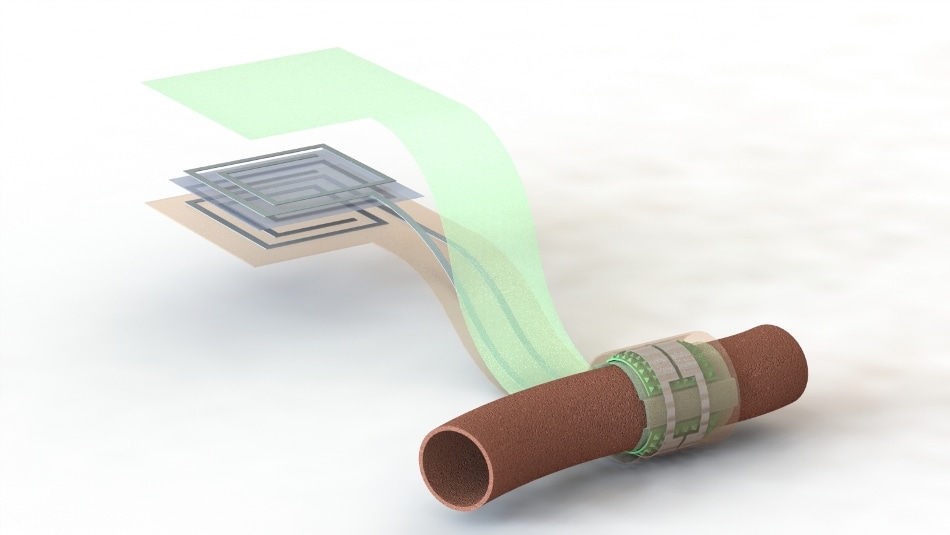Jan 9 2019
Stanford University scientists have developed a new device that could help doctors to easily monitor the success of blood vessel surgery. The sensor, described in a paper published in the January 8th issue of the Nature Biomedical Engineering, monitors the blood flow through an artery. It is battery-free, wireless, and biodegradable, so it is compact and does not need to be removed and it can alert a patient’s doctor if there is a blockage.
 Artist’s depiction of the biodegradable pressure sensor wrapped around a blood vessel with the antenna off to the side (layers separated to show details of the antenna’s structure). (Image credit: Levent Beker)
Artist’s depiction of the biodegradable pressure sensor wrapped around a blood vessel with the antenna off to the side (layers separated to show details of the antenna’s structure). (Image credit: Levent Beker)
Measurement of blood flow is critical in many medical specialties, so a wireless biodegradable sensor could impact multiple fields including vascular, transplant, reconstructive and cardiac surgery. As we attempt to care for patients throughout the Bay Area, Central Valley, California and beyond, this is a technology that will allow us to extend our care without requiring face-to-face visits or tests.
Paige Fox, Assistant Professor of Surgery and Study Co-Senior Author, Stanford University.
Tracking the success of surgery on blood vessels is not easy, as the first sign of trouble frequently comes too late. By that time, the patient mostly needs extra surgery that carries perils similar to the original procedure. This new sensor could allow doctors to keep tabs on a healing vessel from a distance, offering opportunities for earlier interventions.
Flow or no
The sensor wraps closely around the healing vessel, where blood pulsing past pushes on its inner surface. As the shape of that surface varies, it changes the sensor’s capacity to store electric charge, which doctors can detect remotely from a device situated near the skin but outside the body. That device asks a reading by pinging the sensor’s antenna, similar to an ID card scanner. Soon, this device could be available in the form of a stick-on patch or be combined into other technology, like a smartphone or wearable device.
The scientists primarily tested the sensor in an artificial setting where they pumped air via an artery-sized tube to imitate pulsing blood flow. Surgeon Yukitoshi Kaizawa, a former postdoctoral scholar at Stanford and co-author of the paper, also embedded the sensor around an artery in a rat. Even at such a small scale, the sensor effectively reported blood flow to the wireless reader. At this juncture, they were only keen on detecting total blockages, but they did see signs that future versions of this sensor could identify finer instabilities of blood flow.
The sensor is a wireless version of the technology that chemical engineer Zhenan Bao has been designing so as to give prostheses a subtle sense of touch.
“This one has a history,” said Bao, the K. K. Lee Professor in the School of Engineering and co-senior author of the paper. “We were always interested in how we can utilize these kinds of sensors in medical applications but it took a while to find the right fit.”
The scientists had to alter their existing sensor’s materials to make it sensitive to pulsing blood but stiff enough to maintain its shape. They also had to move the antenna to a location where it would be safe, not impacted by the pulsation, and re-design the capacitor so it could be positioned around an artery.
“It was a very exacting project and required many rounds of experiments and redesign,” said Levent Beker, co-lead author of the paper and a postdoctoral scholar in the Bao lab. “I’ve always been interested in medical and implant applications and this could open up a lot of opportunities for monitoring or telemedicine for many surgical operations.”
Making connections
The idea of an artery sensor started to take shape when former postdoctoral fellow Clementine Boutry of the Bao lab sought out Anaïs Legrand, who was a postdoctoral fellow in the Fox lab, and connected those groups—together with the lab of James Chang, the Johnson and Johnson Professor of Surgery.
Once they fixed their aim on the biodegradable blood flow monitor, the partnership won a 2017 Postdocs at the Interface seed grant from Stanford ChEM-H, which supports postdoctoral research partnerships investigating potentially transformative new ideas.
We both value our postdoctoral researchers but did not anticipate the true value this meeting would have for a long-term productive partnership.
Paige Fox, Assistant Professor of Surgery and Study Co-Senior Author, Stanford University.
The scientists are currently finding the ideal way to attach the sensors to the vessels and tweaking their sensitivity. They are also looking forward to other ideas that may come as interest expands in this interdisciplinary area.
Using sensors to allow a patient to discover problems early on is becoming a trend for precision health. It will require people from engineering, from medical school and data people to really work together, and the problems they can address are very exciting.
Zhenan Bao, Study Co-Senior Author and the K. K. Lee Professor, School of Engineering, Stanford University.